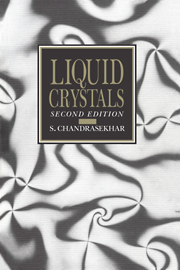4 - Cholesteric liquid crystals
Published online by Cambridge University Press: 08 January 2010
Summary
Optical properties
The unique optical properties of the cholesteric phase were recognized by both Reinitzer and Lehmann at the time of their early investigations which culminated in the discovery of the liquid crystalline state. When white light is incident on a ‘planar’ sample (whose optic axis is perpendicular to the glass surfaces) selective reflexion takes place, the wavelengths of the reflected maxima varying with angle of incidence in accordance with Bragg's law. At normal incidence, the reflected light is strongly circularly polarized; one circular component is almost totally reflected over a spectral range of some 100 °, while the other passes through practically unchanged. Moreover, contrary to usual experience, the reflected wave has the same sense of circular polarization as that of the incident wave.
Along its optic axis, the medium possesses a very high rotatory power, usually of the order of several thousands of degrees per millimetre. In the neighbourhood of the region of reflexion, the rotatory dispersion is anomalous and the sign of the rotation opposite on opposite sides of the reflected band. The behaviour is rather similar to that of an optically active molecule in the vicinity of an absorption. Following the theoretical work of Mauguin, Oseen and de Vries these remarkable properties can now be explained quite rigorously in terms of the spiral structure represented schematically in fig. 1.1.4.
Propagation along the optic axis for wavelengths ≪ pitch
Basic theory
We shall first consider the propagation of light along the optic axis for wavelengths much smaller than the pitch so that reflexion and interference effects may be neglected.
- Type
- Chapter
- Information
- Liquid Crystals , pp. 213 - 299Publisher: Cambridge University PressPrint publication year: 1992
- 5
- Cited by



